
Before the railroad arrived in 1881, Holbrook, located where the Rio Pureco joined the Little Colorado, was known as Horsehead Crossing. Just east of the river crossing, Berardo Freyes ran a saloon for a man named Juan Padilla. Travelers passing through began calling the place, Berardo Station. Berardo had a pretty wife who was both free-spirited and entrepreneurial. She opened a restaurant and store in the bar and caught the beguiling fancy of Henry Huning, a lonesome bachelor from Showlow. He managed to get Berardo drunk on his own whiskey one night and rode off into the sunset with the saloonkeeper’s winsome esposa.
The community was renamed Holbrook in 1882 for H.R. Holbrook, who was the first engineer on the Atlantic and Pacific Railroad. By 1887, the town had about two hundred fifty residents. Businesses included a Chinese restaurant run by a man named Louey Ghuey, Nathan Barth’s store, Schuster’s store, and five or six saloons. Contrary to popular myth, there never was a “Bucket of Blood” saloon. That was a humorous nickname given by the cowboys to any rough and tumble drinking establishment.
The socially elite of the town included the wide gamut of colorful frontier types: filles de joie, gamblers, sheepherders, cowboys and railroaders.
Holbrook in those days was, to paraphrase Mark Twain, “Holbrook no place for a Presbyterian………” so very few remained Presbyterians, or any other religion for that matter. In fact, the town had the unique distinction of being the only county seat in the United States that had no church until 1913. And that only came after Mrs. Sidney Sapp cajoled her attorney husband into organizing a building fund to build one.






